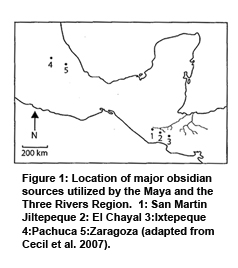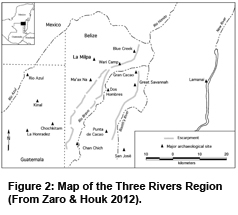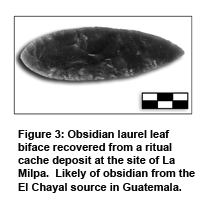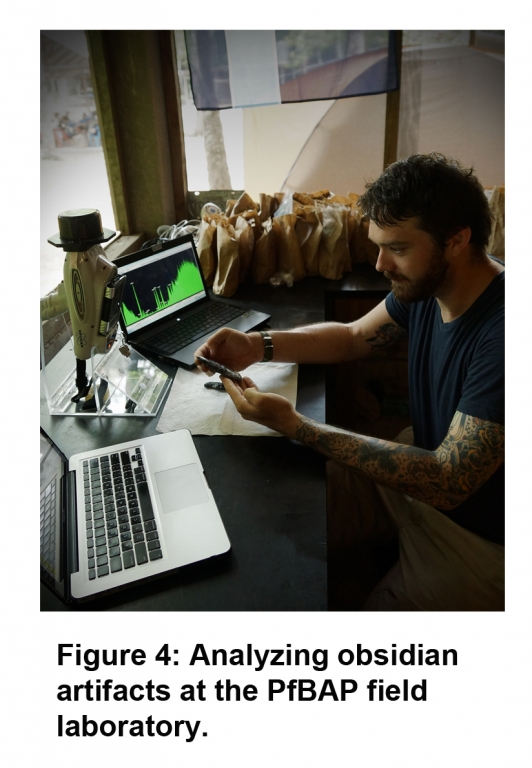
Maya Obsidian of the Three Rivers region, Belize
Maya Obsidian of the Three Rivers region, Belize
May 17th, 2012 to June 14th, 2012
CCI Participant: Walter Beckwith
Funding Support: Dan and Betty Churchill Fund, Programme for Belize Archaeological Project.
The Ancient Maya of southern Mexico, Guatemala, Belize and Honduras represent one of the most complex and sophisticated pre-Columbian societies in the Americas. For nearly 2000 years, these people wrought a civilization from the region’s thick, tropical forests, which at its height was home to upwards of five million people.
While the research interests of Maya archaeology are many, Maya political economy and interaction has long been a focus. The movement of non-local materials into areas distant from their origin have the potential to speak directly to these larger issues. Of the many non-local materials ferried throughout the Maya lowlands, obsidian, a volcanic glass used in the production of a variety of military, ritual and utilitarian artifacts, is nearly omnipresent. Almost no Maya archaeological site is absent of this widely distributed material. However, unlike the wide distribution of Maya obsidian artifacts, geologic sources of the raw material are much more discrete occurring only in specific geographic contexts. In the case of the Maya region, raw obsidian can only found in the highlands of southern Guatemala and throughout Central Mexico often traversing great distances through complex exchange networks before making its way to its final internment into the archaeological record.
This study seeks to understand the dynamics behind Maya socio-political and economic interaction as it is seen through the movement and distribution of obsidian throughout the Three Rivers region of northwestern Belize. Through the use of a variety of geochemical analytical tools, one can discern the geological origin of a particular obsidian artifact. A selection of artifacts housed at the Programme for Belize Archaeological Project’s (PfBAP) field laboratory in Northwestern Belize was analyzed using portable energy dispersive x-ray fluorescence spectrometry (PXRF) instrumentation. Obsidian artifacts curated at the field laboratory have been collected from the various archaeological surveys and excavations conducted under the PfBAP, many of which stem from a variety of cultural and temporal contexts and site types. Such a broad and regional sample allows for great insight into ancient Maya socio-economic dynamics and interaction.
Preliminary analysis of the data suggests that the Maya obsidian of the Three Rivers region imported from at least seven different geologic sources. El Chayal, Ixtepeque and the San Martin Jilotepeque sources of southern highland Guatemala are the most commonly represented sources in the assemblages. The green-gold obsidian of the Pachuca source in Central Mexico was also identified in the collections demonstrating a long distance interaction with non-Maya “foreign” groups to the west. The three other source groups identified by the PXRF require additional analysis before source determinations can be made. It is likely that they are also of central Mexican origin given the high amounts of Zirconium relative to Strontium.
While much of the analysis of the data generated during the course of this fieldwork remains to be done, it is apparent that the acquisition and exchange of obsidian in the Three Rivers region was a very dynamic process. Changes in the frequency of Guatemalan obsidian over time or context can provide a proxy to gauge changing political ties with other regional polities. The presence of central Mexican obsidian suggests ties with these distant areas or, at the very least, those with the means to facilitate such long distance exchange. Funding for this project was graciously provided by the Dan and Betty Churchill Exploration fund and the Programme for Belize Archaeological Project. PXRF equipment was provided with the gracious support of Dr. Bruce Kaiser of Bruker-AXS.





